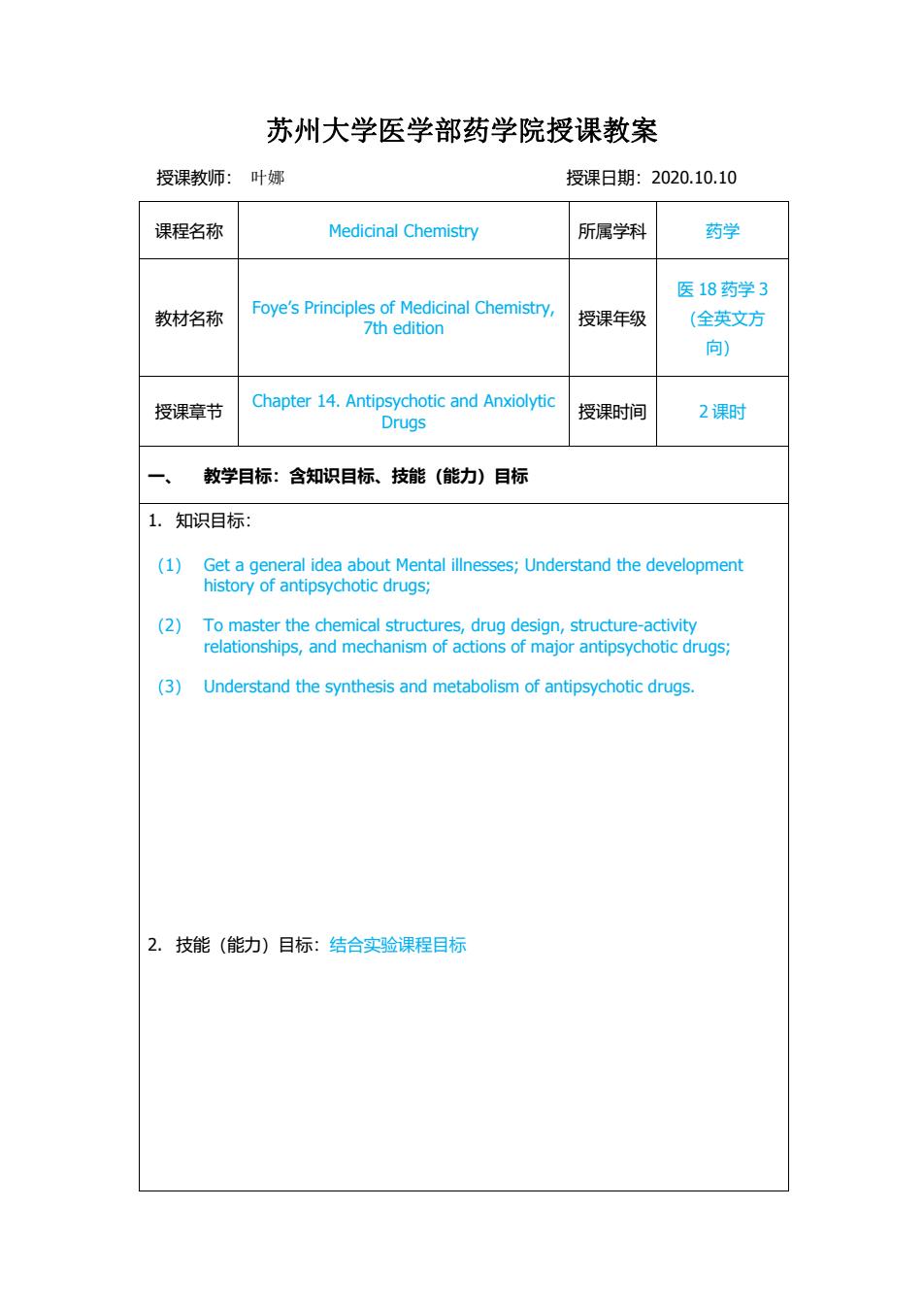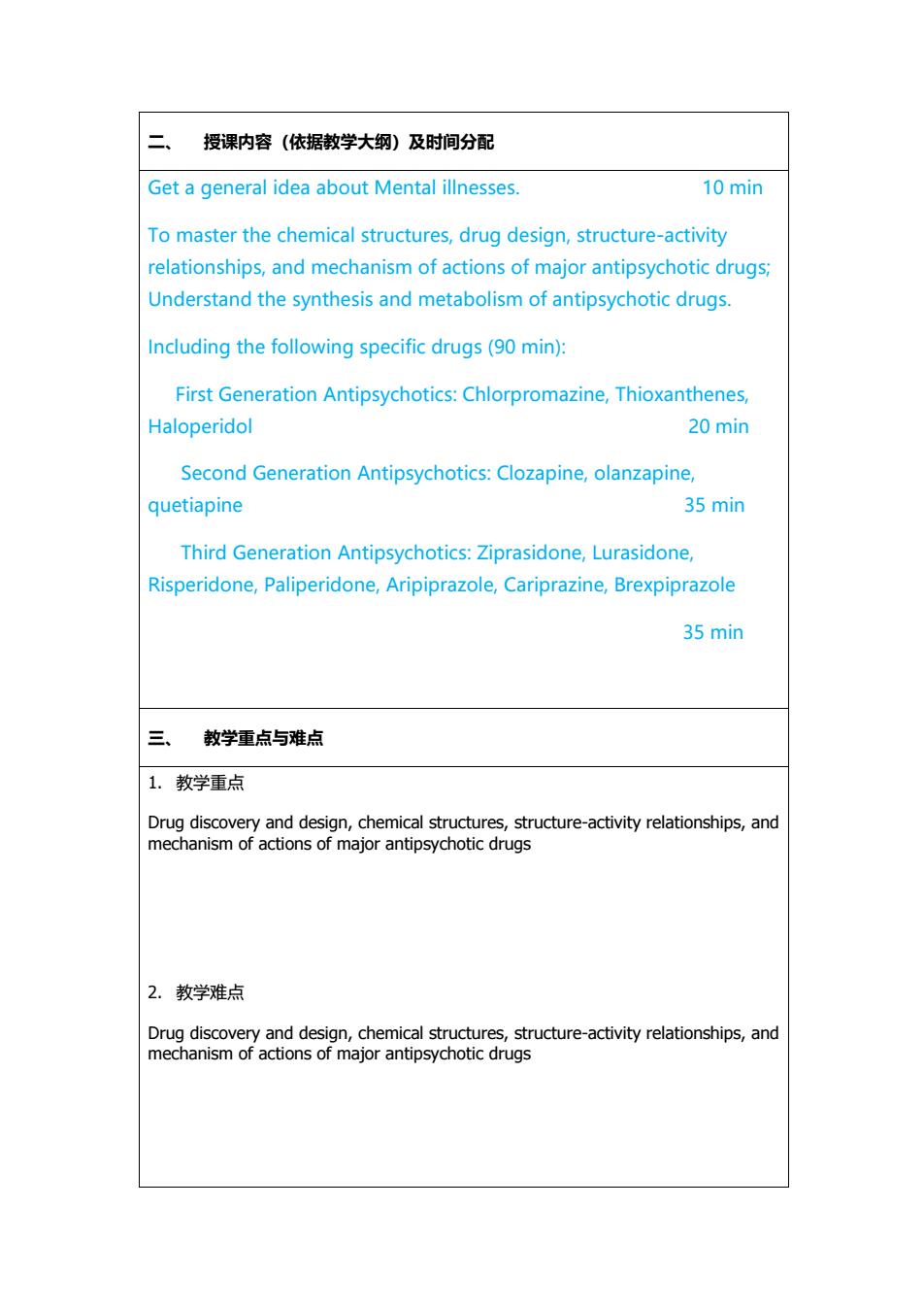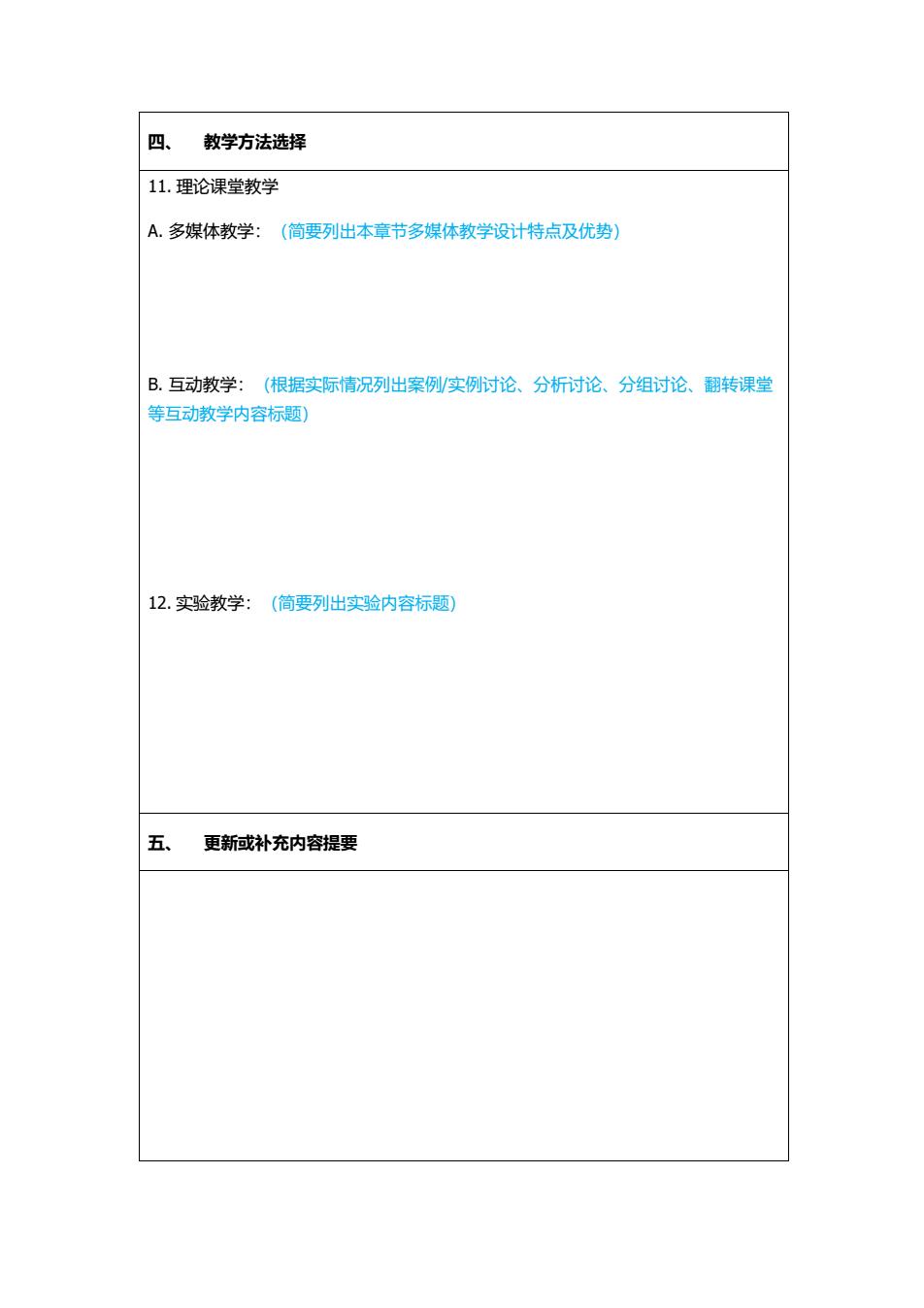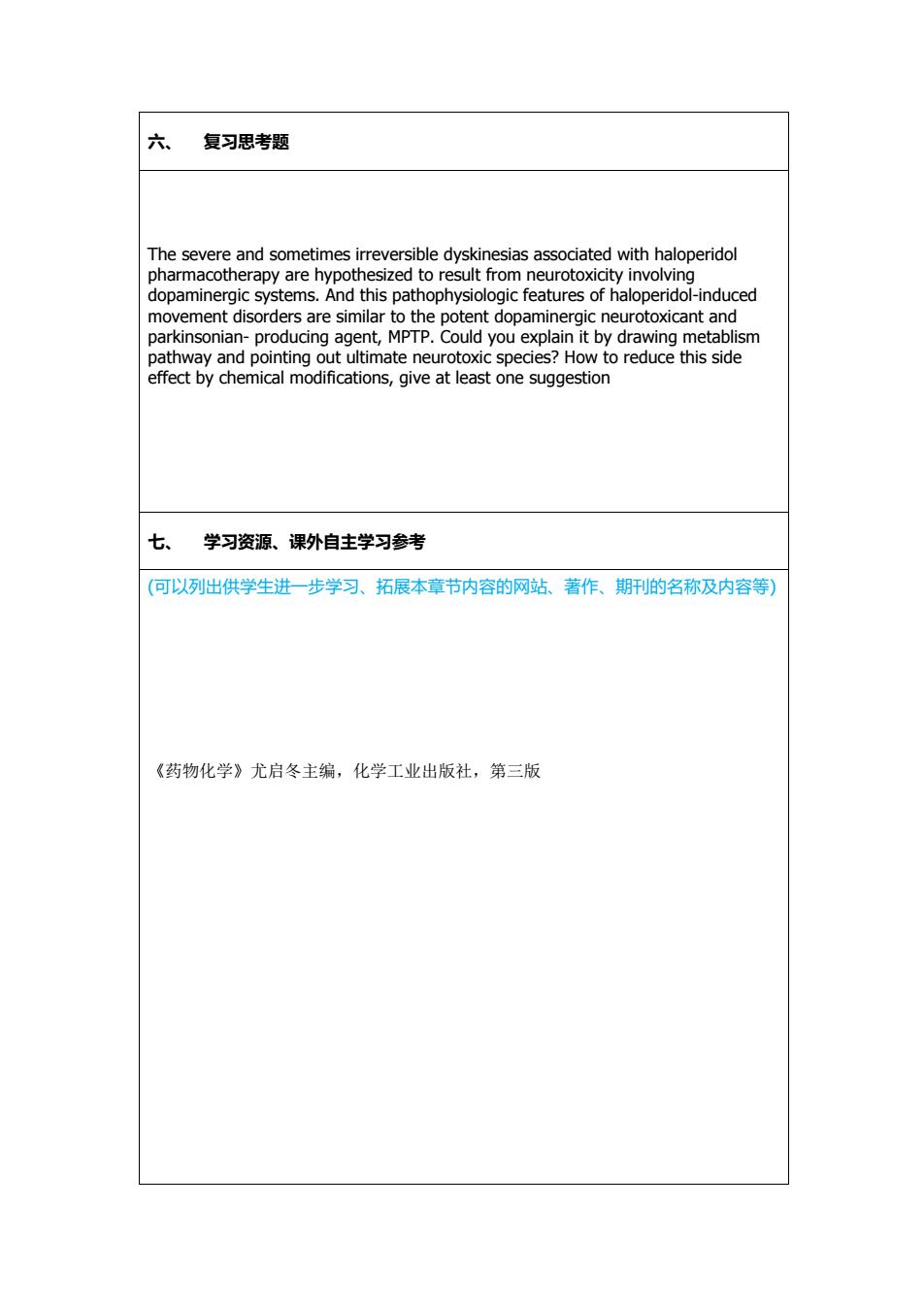
六、 复习思考题 Parkinson'disease (PD)is a slowly progressive,neurodegeneration disorder characterized by losing dopamine neuron in the substantia nigra, leading to a deficiency of the neurotransmitter (Dopamine)in DA nerve terminals. 1)Please write the detailed biochemistry of dopamine,including how it is biosynthesized and metabolized. 2)Can we directly administer dopamine for treatment of PD?Why? 3)What is the golden standard for the treatment of PD?Why it has very limited dose effectiveness?How can we make it more efficient? 七、 学习资源、课外自主学习参考 (何以列出供学生进一步学习、拓展本章节内容的网站、著作、期肝刊的名称及内容等) 《药物化学》尤启冬主编,化学工业出版社,第三版
六、 复习思考题 Parkinson’ disease (PD) is a slowly progressive, neurodegeneration disorder characterized by losing dopamine neuron in the substantia nigra, leading to a deficiency of the neurotransmitter (Dopamine) in DA nerve terminals. 1) Please write the detailed biochemistry of dopamine, including how it is biosynthesized and metabolized. 2) Can we directly administer dopamine for treatment of PD? Why? 3) What is the golden standard for the treatment of PD? Why it has very limited dose effectiveness? How can we make it more efficient? 七、 学习资源、课外自主学习参考 (可以列出供学生进一步学习、拓展本章节内容的网站、著作、期刊的名称及内容等) 《药物化学》尤启冬主编,化学工业出版社,第三版

苏州大学医学部药学院授课教案 授课教师:叶娜 授课日期:2020.10.10 课程名称 Medicinal Chemistry 所属学科 药学 医18药学3 教材名称 Foye's Principles of Medicinal Chemistry, 7th edition 授课年级 (全英文方 向) 授课章节 Chapter 14.Antipsychotic and Anxiolytic 授课时间 2课时 Drugs 一、 教学目标:含知识目标、技能(能力)目标 1.知识目标: (1)Get a general idea about Mental illnesses;Understand the development history of antipsychotic drugs; (2)To master the chemical structures,drug design,structure-activity relationships,and mechanism of actions of major antipsychotic drugs; (3)Understand the synthesis and metabolism of antipsychotic drugs. 2.技能(能力)目标:结合实验课程目标
苏州大学医学部药学院授课教案 授课教师: 叶娜 授课日期:2020.10.10 课程名称 Medicinal Chemistry 所属学科 药学 教材名称 Foye’s Principles of Medicinal Chemistry, 7th edition 授课年级 医 18 药学 3 (全英文方 向) 授课章节 Chapter 14. Antipsychotic and Anxiolytic Drugs 授课时间 2 课时 一、 教学目标:含知识目标、技能(能力)目标 1. 知识目标: (1) Get a general idea about Mental illnesses; Understand the development history of antipsychotic drugs; (2) To master the chemical structures, drug design, structure-activity relationships, and mechanism of actions of major antipsychotic drugs; (3) Understand the synthesis and metabolism of antipsychotic drugs. 2. 技能(能力)目标:结合实验课程目标

二 授课内容(依据教学大纲)及时间分配 Get a general idea about Mental illnesses. 10 min To master the chemical structures,drug design,structure-activity relationships,and mechanism of actions of major antipsychotic drugs; Understand the synthesis and metabolism of antipsychotic drugs Including the following specific drugs(90 min): First Generation Antipsychotics:Chlorpromazine,Thioxanthenes, Haloperidol 20 min Second Generation Antipsychotics:Clozapine,olanzapine, quetiapine 35 min Third Generation Antipsychotics:Ziprasidone,Lurasidone, Risperidone,Paliperidone,Aripiprazole,Cariprazine,Brexpiprazole 35 min 三、 教学重点与难点 1.教学重点 Drug discovery and design,chemical structures,structure-activity relationships,and mechanism of actions of major antipsychotic drugs 2.教学难点 Drug discovery and design,chemical structures,structure-activity relationships,and mechanism of actions of major antipsychotic drugs
二、 授课内容(依据教学大纲)及时间分配 Get a general idea about Mental illnesses. 10 min To master the chemical structures, drug design, structure-activity relationships, and mechanism of actions of major antipsychotic drugs; Understand the synthesis and metabolism of antipsychotic drugs. Including the following specific drugs (90 min): First Generation Antipsychotics: Chlorpromazine, Thioxanthenes, Haloperidol 20 min Second Generation Antipsychotics: Clozapine, olanzapine, quetiapine 35 min Third Generation Antipsychotics: Ziprasidone, Lurasidone, Risperidone, Paliperidone, Aripiprazole, Cariprazine, Brexpiprazole 35 min 三、 教学重点与难点 1. 教学重点 Drug discovery and design, chemical structures, structure-activity relationships, and mechanism of actions of major antipsychotic drugs 2. 教学难点 Drug discovery and design, chemical structures, structure-activity relationships, and mechanism of actions of major antipsychotic drugs

四、 教学方法选择 11.理论课堂教学 A.多媒体教学:(简要列出本章节多媒体教学设计特点及优势) B.互动教学:(根据实际情况列出案例/实例讨论、分析讨论、分组讨论、翻转课堂 等互动教学内容标题) 12.实验教学:(简要列出实验内容标题) 五、 更新或补充内容提要
四、 教学方法选择 11. 理论课堂教学 A. 多媒体教学:(简要列出本章节多媒体教学设计特点及优势) B. 互动教学:(根据实际情况列出案例/实例讨论、分析讨论、分组讨论、翻转课堂 等互动教学内容标题) 12. 实验教学:(简要列出实验内容标题) 五、 更新或补充内容提要

六 复习思考题 The severe and sometimes irreversible dyskinesias associated with haloperidol pharmacotherapy are hypothesized to result from neurotoxicity involving dopaminergic systems.And this pathophysiologic features of haloperidol-induced movement disorders are similar to the potent dopaminergic neurotoxicant and parkinsonian-producing agent,MPTP.Could you explain it by drawing metablism pathway and pointing out ultimate neurotoxic species?How to reduce this side effect by chemical modifications,give at least one suggestion 七、 学习资源、课外自主学习参考 (可以列出供学生进一步学习、拓展本章节内容的网站、著作、期肝刊的名称及内容等) 《药物化学》尤启冬主编,化学工业出版社,第三版
六、 复习思考题 The severe and sometimes irreversible dyskinesias associated with haloperidol pharmacotherapy are hypothesized to result from neurotoxicity involving dopaminergic systems. And this pathophysiologic features of haloperidol-induced movement disorders are similar to the potent dopaminergic neurotoxicant and parkinsonian- producing agent, MPTP. Could you explain it by drawing metablism pathway and pointing out ultimate neurotoxic species? How to reduce this side effect by chemical modifications, give at least one suggestion 七、 学习资源、课外自主学习参考 (可以列出供学生进一步学习、拓展本章节内容的网站、著作、期刊的名称及内容等) 《药物化学》尤启冬主编,化学工业出版社,第三版